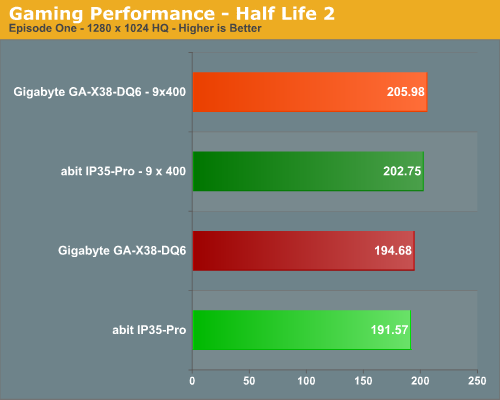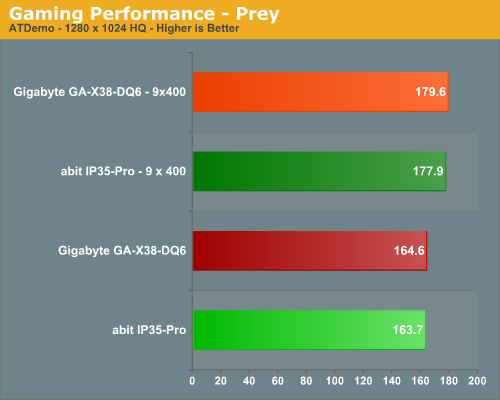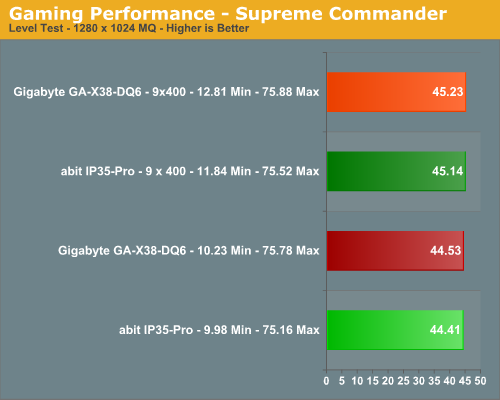Gigabyte GA-X38-DQ6: An early look at X38
by Gary Key on September 4, 2007 3:00 AM EST- Posted in
- Motherboards
Gaming Performance
As usual, gaming performance was tested with a variety of current games. We ran our benchmarks at a 1280x1024 resolution with high quality settings
Battlefield 2
This benchmark is performed using DICE's built-in demo playback functionality with additional capture capabilities designed in house. During the benchmark, the camera switches between players and vehicles in order to capture the most action possible. There is a significant amount of smoke, explosions, and vehicle usage as this a very GPU intensive Battlefield 2 benchmark. We run Battlefield 2 using medium quality graphics settings available in the video settings. The game itself is best experienced with average in-game frame rates of 35 and up.

Half Life 2: Episode One
We use the built-in timedemo feature to benchmark the game. Our timedemo consists of starting at the bottom of the hill near the lake and ending in the old church. The Source engine timedemo feature is similar to the nettimedemo of Id's Doom 3 engine, in that it plays back more than just the graphics. The visual quality settings were set to high or medium where possible with HDR off. While the Source engine is notorious for giving great frame rates for almost any hardware setup, we find the game isn't as enjoyable if it isn't running at 30fps or above.

Prey
Prey offers some superb action sequences, unique weapons and characters, and is a visually stunning game at times. It still requires a very good GPU to run it with all of the eye candy turned on. We set all graphic settings to their maximum except for AA/AF and utilize a custom timedemo that takes place during one of the more action oriented sequences. We generally find the game to be enjoyable with an average frame rate above 35fps.

Supreme Commander
Supreme Commander is one of the favorite real time strategy games around the office as it continues to provide a great deal of replay value and the graphics are very good once the eye candy is turned on. What we especially like about the game is the fact that it can bring the best system to its knees and that fact makes it a great system benchmark. This particular game requires both a very good CPU and GPU when playing the game at anything above 1024x768 with decent settings. We utilize the game's built-in benchmark and generally find the game to be enjoyable with an average frame rate above 25fps.

Gaming Summary
Although the X38 board consistently finishes first in all of our benchmarks, the differences only average around 1% to 2% at this time. We fully expect the retail level boards to improve upon these scores by a couple of percent, but the net result is that GPU choice will still be a much bigger consideration than the motherboard chipset. Once we receive the shipping BIOS and retail board, we will revisit these same games and provide CrossFire results against the P35 and 975X equipped boards.
As usual, gaming performance was tested with a variety of current games. We ran our benchmarks at a 1280x1024 resolution with high quality settings
Battlefield 2
This benchmark is performed using DICE's built-in demo playback functionality with additional capture capabilities designed in house. During the benchmark, the camera switches between players and vehicles in order to capture the most action possible. There is a significant amount of smoke, explosions, and vehicle usage as this a very GPU intensive Battlefield 2 benchmark. We run Battlefield 2 using medium quality graphics settings available in the video settings. The game itself is best experienced with average in-game frame rates of 35 and up.

Half Life 2: Episode One
We use the built-in timedemo feature to benchmark the game. Our timedemo consists of starting at the bottom of the hill near the lake and ending in the old church. The Source engine timedemo feature is similar to the nettimedemo of Id's Doom 3 engine, in that it plays back more than just the graphics. The visual quality settings were set to high or medium where possible with HDR off. While the Source engine is notorious for giving great frame rates for almost any hardware setup, we find the game isn't as enjoyable if it isn't running at 30fps or above.

Prey
Prey offers some superb action sequences, unique weapons and characters, and is a visually stunning game at times. It still requires a very good GPU to run it with all of the eye candy turned on. We set all graphic settings to their maximum except for AA/AF and utilize a custom timedemo that takes place during one of the more action oriented sequences. We generally find the game to be enjoyable with an average frame rate above 35fps.

Supreme Commander
Supreme Commander is one of the favorite real time strategy games around the office as it continues to provide a great deal of replay value and the graphics are very good once the eye candy is turned on. What we especially like about the game is the fact that it can bring the best system to its knees and that fact makes it a great system benchmark. This particular game requires both a very good CPU and GPU when playing the game at anything above 1024x768 with decent settings. We utilize the game's built-in benchmark and generally find the game to be enjoyable with an average frame rate above 25fps.

Gaming Summary
Although the X38 board consistently finishes first in all of our benchmarks, the differences only average around 1% to 2% at this time. We fully expect the retail level boards to improve upon these scores by a couple of percent, but the net result is that GPU choice will still be a much bigger consideration than the motherboard chipset. Once we receive the shipping BIOS and retail board, we will revisit these same games and provide CrossFire results against the P35 and 975X equipped boards.










26 Comments
View All Comments
jay401 - Tuesday, September 4, 2007 - link
How does it compare to the previous gen motherboards almost everyone is running?Is it really worth an upgrade from 650i/680i/P965/975X?
That's really what matters.
TA152H - Tuesday, September 4, 2007 - link
The chart "Media encoding - Sony Vegas" makes no sense. I think you got the stock performances twisted.Also three to five percent over the P35 sounds incredible, as in not credible. Especially with the Penryn (with it's bigger cache). When the motherboard makers talk this, you should try to find out what processor they are talking about. Maybe on a 512K processor it can reach it, but on a 4 MB processor, on most benchmarks, it doesn't sound realistic at all. Well, it also depends what they are comparing it to. It says the P35, but maybe they meant the 975X, which is much more likely. Crossfire, of course, will be much higher, but how many people are actually using this? It's a very, very low percentage. So, I think people are going to be disappointed again, like they were with the Penryn, because of misguided expectations. Penryn, like x38, is a great product, it's a shame people lose that because of these unrealistic expectations. Still, anything is possible, but if it averages 4% on most applications against the P35, on a Penryn (will enthusiasists buy the Conroe when it comes out?), I'd be very surprised.
One suggestion, when you do the final review, run it with a Conroe-L as well. Why would an enthusiast site run this as well? Well, if I needed a machine, right now (as in I had one computer and it died), I would buy it for $40 and then buy a Penryn when it became available, or cheap, and then use it in a low power computer. You might see the 3-5% claim have a chance on a small cache processor. That's probably what they were talking about, without actually wanting to say it.
phusg - Tuesday, September 4, 2007 - link
Sounds an interesting upgrade path. But aren't Conroe-L's the Celeron 4xx's which are socket 478? Do we even know what socket Penryn will be?
TA152H - Tuesday, September 4, 2007 - link
Conroe-L is LGA 775, same as Penryn will be. I suspect almost any motherboard being made now will work with the Penryn, or whatever the desktop version is called, really. I can't keep up with these stupid names AMD and Intel come up with for their processors. The ass that thought of Barcelona should be sterilized. What an absurd name. If they had any brains they might make code names and add something like -L for light, -M for mobile, -S for server, -QM for Quad Mobile, etc...Instead, they have these horrendous code names, which are suitably replaced by horrendous model numbers. I really can't keep track. Pentium III 1 GHz was so much easier to remember.
Guuts - Tuesday, September 4, 2007 - link
Gary,Page 2: Third paragraph from the bottom, should have (DDR2-1066) and not (DDR-1066).
Page 3: Missing graphic at the top of the page, text starting off with "memory-lg.png memory-sm.png" is probably the cause?
Page 5: Chart 2 (Sony Vegas) either has the stock speed bars' labels reversed, or your text summary is incorrect, as the chart doesn't show the Gigabyte board ahead in both stock and overclocked speeds.
Page 7: Second paragraph, last sentence, "...better than several retails boards" should just be "retail".
Good article overall, though I was expecting a bit more of an improvement over the P35. I bet there will be a nice boost over the 975X when we see the full review, however. Thanks for the early look, Gary.
Now...where is the P35 board roundup? :-p
JarredWalton - Tuesday, September 4, 2007 - link
Hi - sorry about the graph missing... that was my mistake. You can blame me for a few other missed typos as well if you'd like. I'm not sure on the Sony Vegas chart if there's some sort of labeling error or if we need to correct the text, so I'm leaving it alone.--Jarred